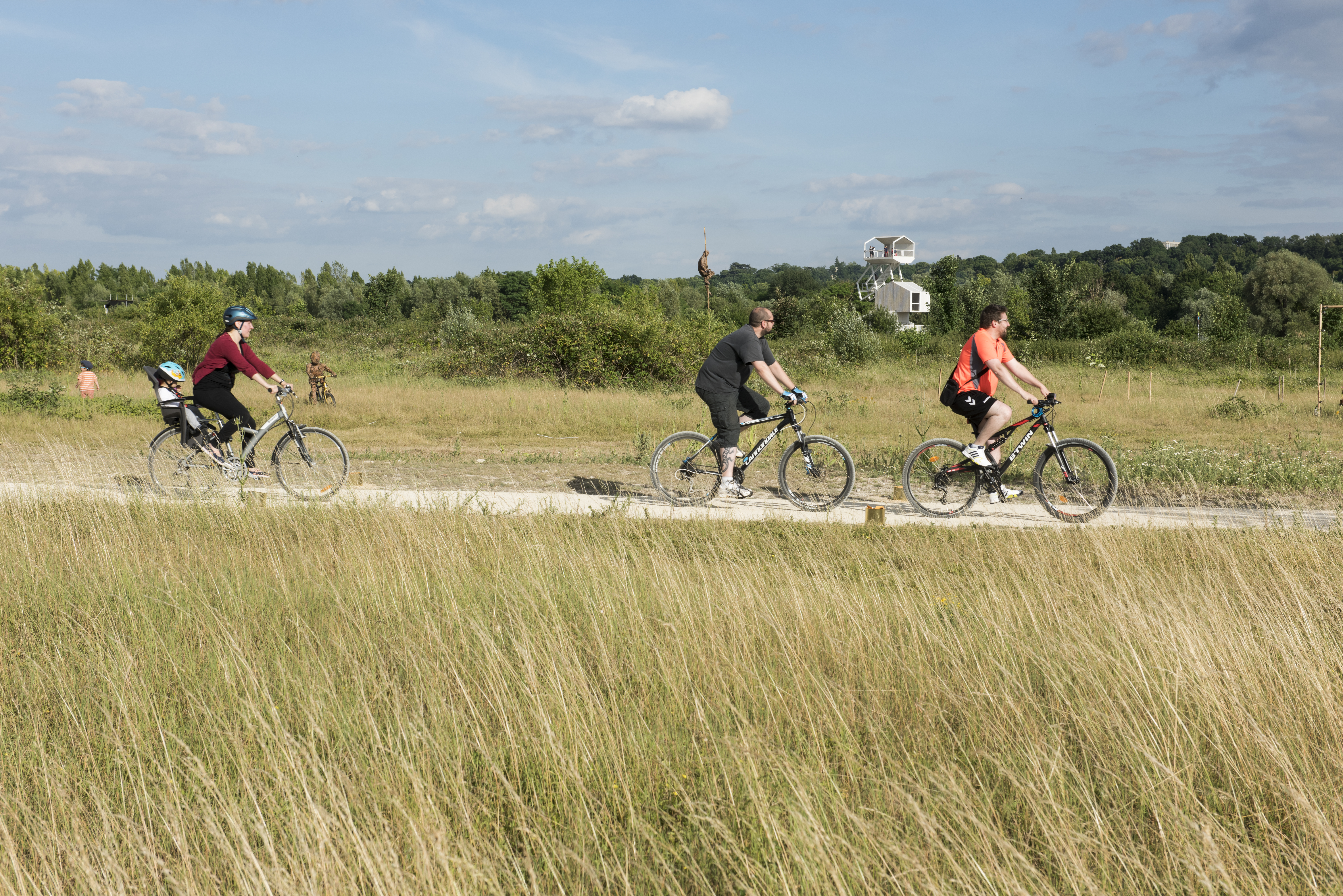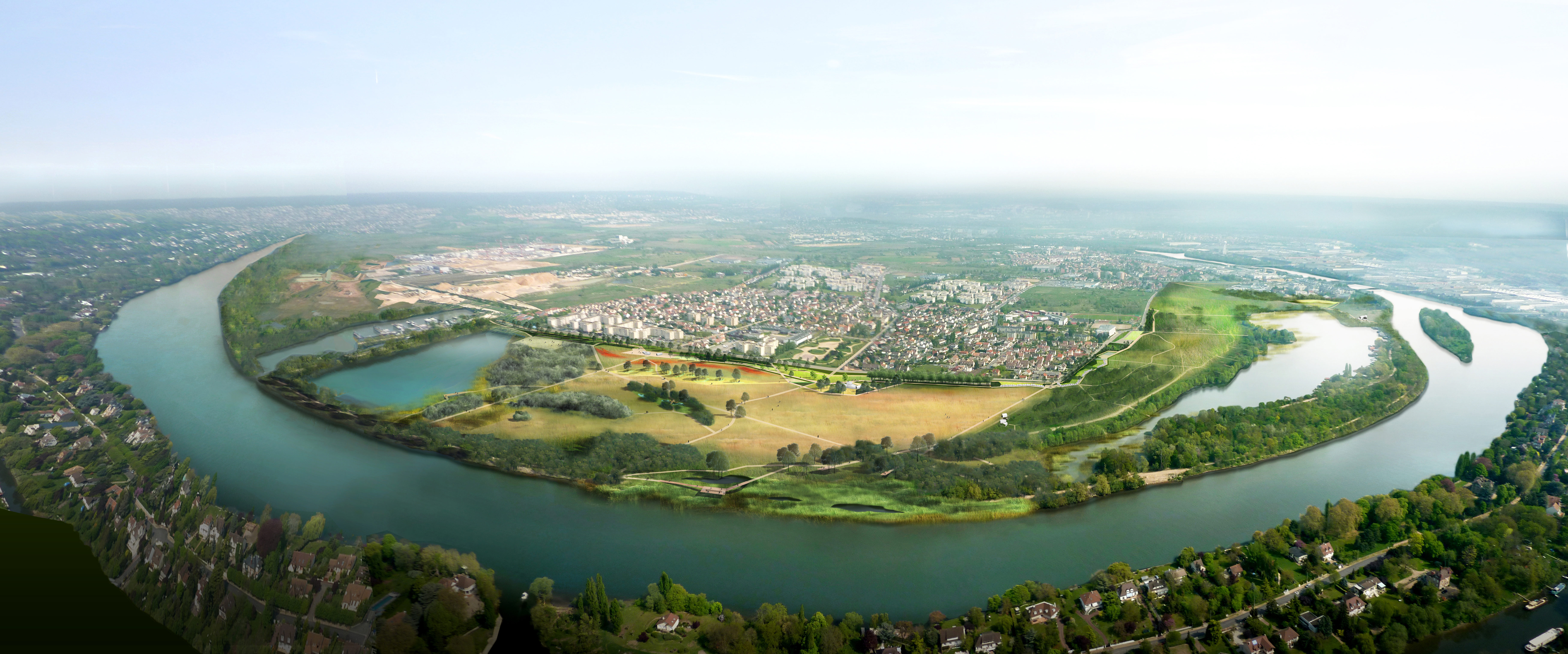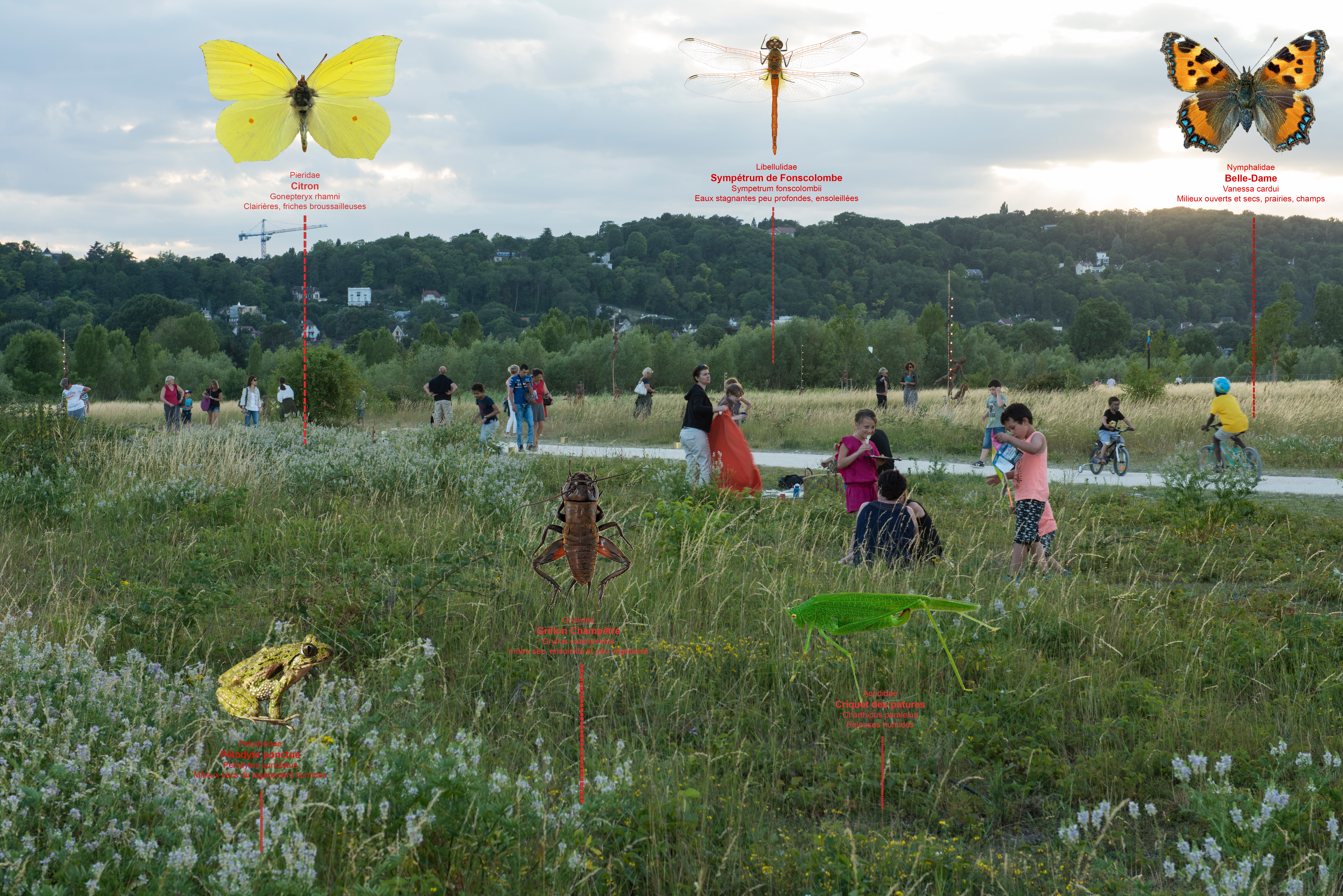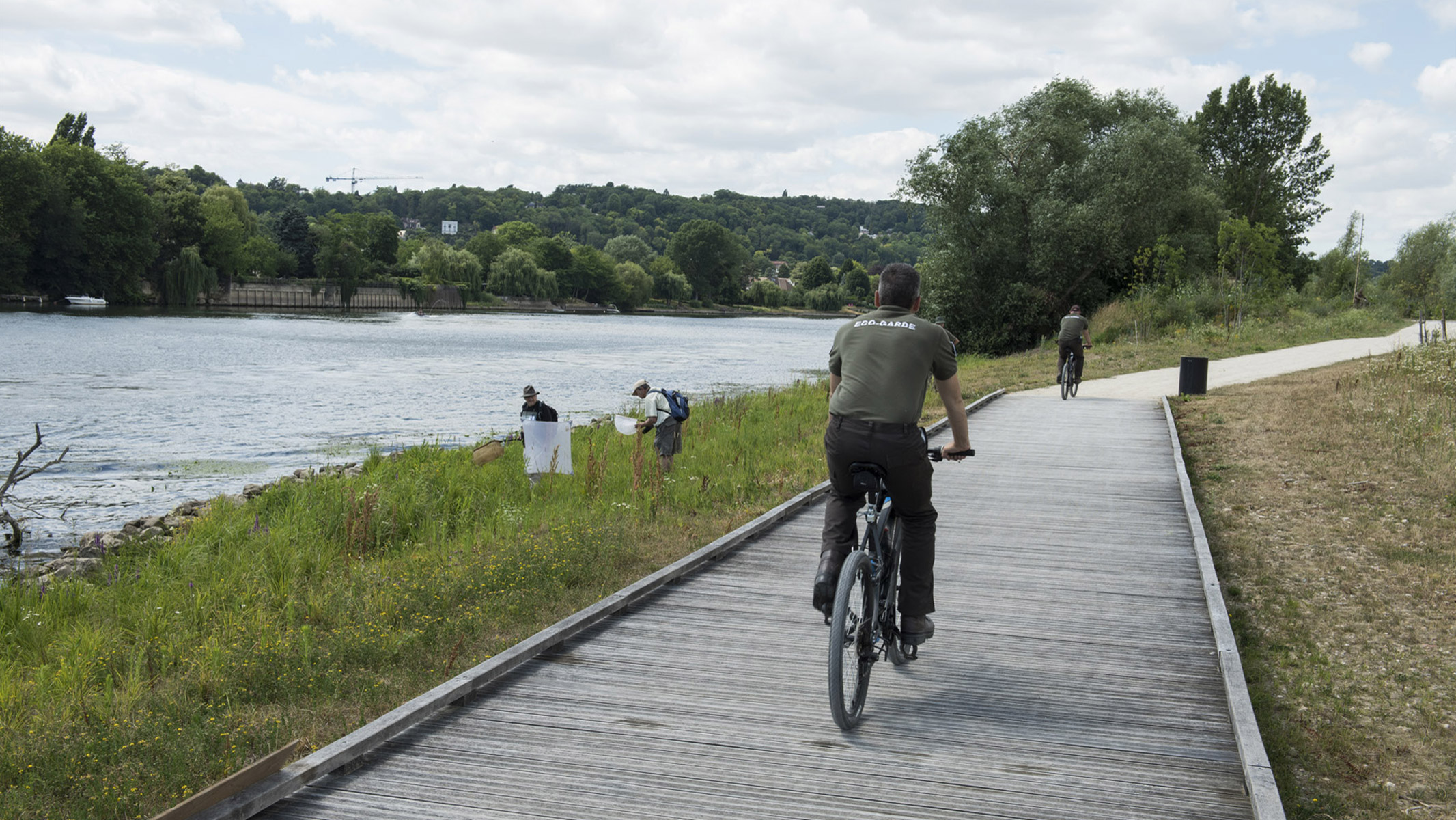Concurrently with the territorial strategy study OIN Seine Aval (Downstream Seine, Operation of National Interest), Agence Ter designed the transformation of a floodable site consisting of former sand quarries into an ecological park and environmentally sensitive area within the confines of a meander of the Seine.
Faced with potential flooding of the river, the park can absorb the water while protecting nature, thanks to the restoration of 113 hectares of the environment to accommodate ecotone
A system of pathways and observation platforms allows the public to access the river, whose banks have been remodeled. A large grassy area with steppe-type regional herbaceous vegetation in the center of the park forms a biome that has become an ecological reserve favorable to certain fauna, as well as a place to welcome and observe insects.
Please highlight how the project can be exemplary in this context
This project is exemplary because it places the “People of the Grass”, the world of insects and biodiversity, at the heart of a contemporary ecological park symbol of a new world where the human and the non-human co-exist.
Please highlight how the project can be exemplary in this context
This project was a new kind of demand in the career our agency, we were rather used to working on parks of smaller areas in very dense urban settings, yet with this order, we faced the development of a 113-hectare site with a budget of €16.8 million including VAT. We carried out a project based on an economy of means. The Parc du Peuple de l'Herbe is, in terms of costs and rationalization of interventions, a project manifesting our need for global resilience.
It reconciles depollution, preservation of existing natural environments and reception of the public with a very low development budget.
The proposed development has defined minimal interventions on certain spaces such as the reinforcement of pre-existing habitats with, for example, a large central heliophilous wasteland in order to favor heavier interventions in terms of work on other spaces such as on the paths and edges of the park that make it possible to create the link with the city and the flow of pedestrians.
The management plan developed by the TER Agency is based on the expertise of differentiated management and the environments are monitored by the teams of the department and many naturalist associations.
Please highlight how the project can be exemplary in this context
To meet this demand for natural space open to the public, we have begun with geologists-naturalists and environmentalists a work of observation and decryption of the site. The dynamics of work between disciplines of experts and landscapers has made it possible to design a project for the restoration of living environments. We have created a platform for negotiation in this park between the world of the living and biodiversity that is often invisible within a public park.
The "People of the Grass" made themselves heard, making the subsoil speak and turning the tiny into a promising concept, capable of responding to the contradiction set out in the project order: this need to negotiate the space between human and non-human. The prefiguration of the park was a magical moment that embarked all the actors around the immensity of the theme "People of the grass".
People of insects, inhabitants, project managers and architects have invited themselves to accompany us to spatially develop the architectures, environments and spaces dedicated to the observation of insects and sports activities for local residents in contact with the park. The park was inaugurated in June 2017 and the attendance of all these "populations" is constantly increasing and many educational actions are organized for the public.
Please highlight how this approach can be exemplary
The three dimensions of sustainability, inclusion and aesthetics are combined in this project because it represents best these dimensions in a vision of the future world: a more resilient world that blends both urban life and nature in a mutual respect.
The dimension of sustainability is very present in this park by the metamorphosis of a landscape marked both by floods and the need to heal the industrial past that has badly led this site. We gave way to the river in this project and gave the Seine its full size of valley in a very dense and urban Ile-de-France region. The soils have been improved and are in the remediation phase.
The aesthetics of the park is very refined but totally controlled. We have implemented paths and furniture in strategic spaces so that strollers can take on the full dimension of the infinitely small world of insects and the infinitely large one of the River.
Inclusion has been installed from programming to realization and even beyond since associations and activities around nature and the People of the Grass continue to multiply. In addition, the park is very popular with local residents, metropolitan visitors and schools.
Reconnecting with nature is one of the many challenges of our society, both in the city and the countryside, all the work of the landscape designers lead us towards this quest. With this natural park project, we had the opportunity to demonstrate in a large space, the size and importance of a river. The Seine is an open space that crosses Paris and its region, it is an essential mobility network but it is above all a natural space that networks the living.
. We conceive of the Rivers in our projects as a common good, a natural heritage but also a space of movement capable of reconnecting with the seasons and understanding the hazards. If we are always in this logic of creating quality spaces, walks, places of discovery, we also make it a point of honor to develop these places by actions that can be carried out on the living.
. Thus, this recomposed alluvial strike (we rectified the banks which were very steep and which had a very low plant quality) makes it possible to install environments that have been deployed, capable of welcoming new species and that support the vagaries and movements of the Seine.
Please also explain the benefits that derived from their involvement.
An insect house installed in the park raises awareness among all audiences about the world of insects, the macro around the theme of the grass people, carrier of biodiversity. This small museum offers the opportunity to see those people of grass in vitro and then go and do field investigations in vivo. There is both a popularization approach but also a scientific approach of observation that becomes a vast field of investigation for schools and inhabitants.
With a surface area of 800 m2, the insect house hosts a ludo-educational exhibition space dedicated to insects with several vivariums and a butterfly aviary. The Opie (Office for Insects and their Environment) offers workshops, animations, field trips and screenings. It is a place of meetings and exchanges for insect enthusiasts. The Department has done some counting and the spectrum of biodiversity has increased.
As part of the policy of preservation and enhancement of sensitive natural areas, the Departmental Council of Yvelines has classified since 2014 the forest the Parc du Peuple de l'herbe as an LPO refuge. This classification promotes the monitoring of ecological diagnoses (typology of habitats, inventory of birds, panels formalizing the Department's commitment to nature).
A continuity of actions promotes the capitalization of knowledge and studies between the department, the OPIE and the Museum of Natural History, allows each visitor to take pictures of plants, insects and bring it back to feed the databases!
This park of more than a hundred hectares extends over old sand pits along the Seine. It is based on an amplification of different environments that habitats for biodiversity have been developed in this project. Located in a flood zone, the park integrates flood risks, staging them by creating an alluvial strike on the scale of the Seine loop in compliance with the dynamics of phytoremediation.
In addition, the park showcases the water level of the Seine likely to flood it very largely thanks to elegant sculptural and minimalist elements of memorial signage.
In the loop of Chanteloup, the alluvial plain of Carrière-sous-Poissy regularly fertilized by the floods of the Seine was once dedicated to market gardening. From 1890 to 2002, the spreading sludge from the Achères wastewater treatment plant was deposited there. This pollution ends up banning all cultivation. Since the 1970s, gravel pits have been exploited and water holes have gradually been backfilled.
The soils still bearing the traces of industrial activity have been depolluted thanks to phytoremediation gardens composed of species known for their virtues of absorption of heavy metals and hydrocarbons. It is by working on the topography, by playing on areas to be dug or backfilled, that we have managed to amplify the environments of dry to very humid areas.
The banks have been completely redesigned to open the park to the river and allow a real connection with nature. The Seine was channeled in the nineteenth century, over-dug, its meanders have been rectified, channeled, adapted to the transport of goods and merchandise therefore the natural cycle has been modified, that of the round trip between the minor bed and the major bed according to rainfall events.
It is this back and forth of rambling, flooding which protected the site from construction that interested us in the project. Little visible, we wanted to amplify it and allow users to visualize this climate phenomenon in motion.
The three dimensions proposed in the competition for the new Bahaus enchant us because they correspond to our convictions as urban landscapers. Sustainability is intrinsic to our profession since we work with the living, inclusion is omnipresent in our agency who have been working for 36 years on many projects on an international scale with many masters of inventive works.
Aesthetics are essential, the beauty of landscapes is increasingly acclaimed as beneficial for the health of populations. Our heritage of Le Nôtre's French garden goes beyond this dimension of perspective and helps us design cities through landscape.
Our references to pioneers of the profession like Olmsted in the USA also refer to the beauty of great sites and social justice: everyone must be able to have access to beauty and the landscape of everyday life must be embellished from city to city.
The innovative aspect here is above all to consider the soils as living spaces. It is through the work of aeration and restoration of the soils that the grass and the People of the grass take place.
In this experience, the world of insects, an invisible and fragile world, which only appears to us when we are bitten or when it hinders our activities has transcended this park project and brought together all the actors. This park proves to us that citizens are ready to share their space with the "wild" and we hope to develop this type of project more in metropolises.
Please provide clear documentation, communication of methodology and principles in this context.
This site transformation project, which has been for thirty years an open-air landfill, was an opportunity to imagine the establishment of new environments it also serves as an example of the decompartmentalization of disciplines that heralds a better world.
Both between the landscaper and the ecologist where teamwork brings here concrete proposals capable of setting in motion: programming, architectural orientations, natural park, resilient aesthetics, social and economic development, respect for the living, amplification of biodiversity.
A very innovative element challenges us around the observatory of insects and birds: the inhabitants participate in this observatory and the researcher becomes a citizen while the citizen becomes a researcher. This is exciting for the coming years and how we will be able to integrate our projects into this integration of the different knowledge of experts.
Considering the grass people as an actor is certainly a concept that must be generalized in many parks. Insects in general are very important in the logic of the food chain of the living, and there are specificities to be made known to the general public. Far from the idea of sanctuarization, it is important to keep in mind a strategy of actively increasing biodiversity in parallel with urban functionalities and living spaces.




@agence ter, 2021
Content licensed to the European Union.